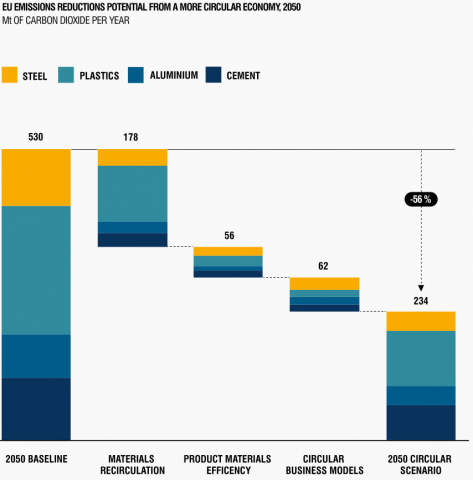
What would be the cheapest, fastest, and very effective means to reduce the Greenhouse Gases (GHG) emissions of energy-intensive industries (steel, plastics, cement and aluminium), which are notoriously "hard to abate"? This is a major question ahead of the COP30 United Nations Climate Change Conference in Belém (Brazil), when all nations will debate their pathways towards net-zero emissions (or, at least, are supposed to, as per the Paris Agreement). The answer may very well be the Circular Economy, as is convincingly demonstrated in this Trusworthy Document that the CosmoPolitical Cooperative has translated and shares in 7 languages: Material Economics (2018) The Circular Economy. A powerful force for climate change mitigation (original language: English).
This report investigates how a more circular economy can contribute to cutting CO2 emissions. It explores a broad range of opportunities for the four largest materials in terms of emissions, namely steel, plastics, aluminium, and cement, and two large use segments for these materials, passenger cars and buildings.
A more circular economy reduces the consumption of virgin materials by:
- narrowing the flows of materials: sharing products, reducing the size of products;
- slowing the flows of materials through the economy: making products that last longer, are maintained, repaired, re-used and re-manufactured;
- closing the flows of materials: ensuring that the materials contained in waste are recycled and re-used with minimal loss in performance and technical features in new products.
The key conclusion is that a more circular economy can make deep cuts to emissions from heavy industry: in an ambitious scenario, as much as 296 million tons CO2 per year in the EU by 2050, out of 530 Mt in total – and some 3.6 billion tonnes per year globally. Making better use of the materials that already exist in the economy thus can take EU industry halfway towards net-zero emissions. Moreover, doing so often is economically attractive. Initiatives for a more circular economy therefore deserve a central place in EU climate and industrial policy.
What did we find interesting in this document?
This report has been a landmark in the climate policy of the European Union - and remains fully relevant 7 years after its publication. It demonstrates and explains very clearly why the Circular Economy, namely all measures aiming at reducing the consumption of virgin materials in the economy, can contribute to the reduction of CO2 emissions from 4 large energy- and CO2 emissions-intensive industries that manufacture them.
In addition, the report quantifies the reductions in CO2 emissions that can stem from a reduction in the use of virgin materials. This reduction is considerable, because the manufacture of virgin basic metal (steel, aluminium), material (cement) or chemical (the monomers that are the precursors of plastics) is a process that inherently consumes energy and / or generates carbon dioxide (because of the physical features of the underlying chemical reaction). Avoiding the use of basic metals, materials or chemicals, or replacing virgin materials with recycled materials, hence saves considerable amounts of CO2 emissions. This document was the first to make the exercise and to consolidate results at the scale of the European Union.
The report hence fully justifies an ambitious Circular Economy policy: the gains don't consist only in saving raw materials (some of which, like iron ore, remaining rather abundant), they are in the mitigation of climate change, and they are considerable. After this report, Circular Economy was no longer a "nice to have" policy. It became a '"must have" policy, one that is absolutely necessary to reach a net-zero target. It is hence a major policy to be defended in the COP30 United Nations Climate Change Conference in Belém (Brazil) of November 2025 - and beyond.
What is it in this document that we disagree with or find disappointing?
One important aspect of the Circular Economy that the report did not touch consists in the economic savings that such a policy entails in the investments needed for the decarbonation of the sectors. If the flows of virgin basic metals, materials and chemicals are reduced, then the size of the facilities that manufacture them can be reduced, and the cost to decarbonise these facilities as well. This leaves room for further work that would quantify these savings. Surprisingly, this quantification has not, to our knowledge, been performed.
